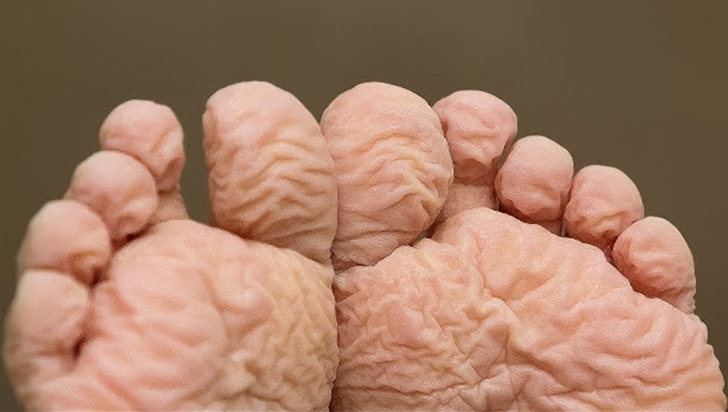13 Couples Who Didn’t Let Society’s Stereotypes Keep Them Apart

Nature has made our bodies wondrously full of marvels and curiosities that scientists are still researching today. For instance, most of us can hold our breath underwater for 90 seconds, without training, and yet in 2016, Spain’s Aleix Segura Vendrell clocked a time of 24 minutes. While he breathed in pure oxygen before immersion, scientists are still trying to figure out how he was able to do that.

When you stay in the water for too long, your skin wrinkles, but not because it absorbs water. Instead, wrinkling is an involuntary reaction by the body’s autonomic nervous system, which controls breathing, heart rate, and perspiration. This reaction causes blood vessels below the skin to constrict, which creates distinctive wrinkles on the fingers and toes. Scientists believe that this process evolved so that humans could have a better grip when their hands are wet.
Our bodies have an incredibly efficient waste system, and this applies to the brain as well. While the blood carries waste materials to be eliminated by the kidneys and intestines, the brain has its own methods of cleansing. Researchers conducted MRI scans on individuals during the deepest stage of non-REM sleep and observed waves of cerebrospinal fluid washing over the brain, effectively removing toxins.
Furthermore, the brain also possesses a mechanism for waste removal. In a separate experiment, scientists scanned the brains of 81 epilepsy patients and discovered lymphatic structures within the brain. These structures guide the flow of waste products out of the skull and towards the lymph nodes in the neck. Hence, the brain has both an automatic cleaning process and a refreshing system.
Low-frequency sounds, below 20 Hz, are inaudible to us but can still be detected on some level. Weather systems, earthquakes, avalanches, and a variety of animals are common sources of these sounds. Studies suggest that we are frequently exposed to these “infrasounds” and prolonged exposure can lead to adverse health effects such as fatigue, headaches, vision problems, dizziness, irritability, and attention issues.

The liver is the only visceral organ that can regenerate itself after damage. The liver can regrow to normal size even after up to 90% of it has been removed.
People vary in terms of the number of muscles they possess, and this goes beyond how muscular or toned they are. For instance, not everyone has the same set of muscles. A forearm muscle known as the palmaris longus is present in many individuals, but absent in many others. Approximately 13% of people are lacking an abdominal muscle called the pyramidalis. Similarly, only around 8% of individuals have an additional chest muscle called the sternalis muscle. These differences in muscle presence or absence highlight the unique variations among individuals.
Recent research has discovered a surprising phenomenon: the liver in many males, both humans and mice, has the ability to switch genders in response to damage. Although it may sound peculiar, it essentially means that the liver can modify its circadian clock and adjust certain hormones to enhance its self-protection mechanism when confronted with a high-fat diet. The presence of the female hormone estrogen, known for its protective properties, is believed to play a significant role in this adaptation. This finding sheds light on the liver’s remarkable ability to adapt and defend itself in the face of dietary challenges.
These broken-down products further trigger genetic switches in the genome, thus altering DNA not only for us but also for the coming generations.
The wisdom passed down by our grandmothers about the importance of our diet is proving to be more accurate than we previously realized. A fascinating field of research called nutrigenomics explores how food impacts us at a profound genetic level. The macronutrients found in food, such as carbohydrates, proteins, fats, vitamins, and minerals, undergo breakdown processes within our bodies to provide the energy we need.
These breakdown products, in turn, activate genetic switches in our genome, resulting in modifications to our DNA. These changes can have implications not just for us but also for future generations. This highlights the significant influence that our diet can have on our genetic makeup, emphasizing the importance of making thoughtful food choices for our overall health and well-being.
There is a fascinating part of the brain called the “claustrum” that plays a crucial role in human consciousness. In a recent study, scientists conducted experiments on a woman who had epilepsy. By stimulating the claustrum, they were able to induce a catatonic state in the woman. When the claustrum was stimulated again, she suddenly woke up, though with a temporary memory lapse from the time when she was in the catatonic state. This intriguing discovery has spurred researchers to delve deeper into the functions and mechanisms of the claustrum. They hope to gain more insights into the intricate workings of the human mind and consciousness.
While it might be unsettling to think about, it’s actually quite common for all of us to have numerous tiny mites residing in the pores of our facial skin. These microscopic creatures are called Demodex, or eyelash mites, and they are too small to be seen with the naked eye. Despite their transparent appearance, these mites feed on sebum, the oily substance produced by our skin. Interestingly, they are unable to excrete, and as a result, they reach the end of their life cycle and explode.
It is believed that the feces left behind by these mites can trigger an immune reaction and contribute to the development of rosacea. While it may sound a bit eerie, it’s important to note that these mites are a normal part of our skin’s microbiome and usually do not cause any major harm.

It is interesting to note that eye color is determined by certain genes, and these genes tend to favor colors other than blue. As a result, the prevalence of blue eyes has been decreasing over time. However, for those who desire blue eyes and are unable to achieve them through contact lenses, there is a new 20-second laser procedure available to transform brown eyes into blue.
It’s important to be aware that this procedure currently carries risks, and it has not yet been medically approved in most countries. Therefore, caution should be exercised before considering such a treatment.
Just as you believed the realm of physical peculiarities had reached its limit, an entirely new realm of captivation lies ahead. Get ready to shift from the unusual to the splendid, as we delve into the enchanting realm of celebrity physiques, unraveling the scientific basis for their irresistible charm.











